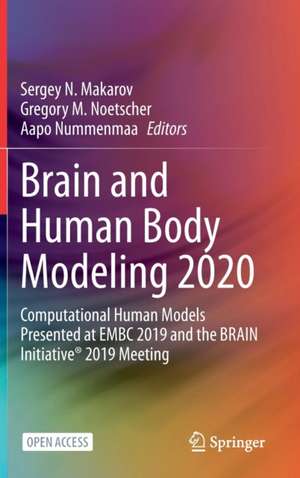Brain and Human Body Modeling 2020: Computational Human Models Presented at EMBC 2019 and the BRAIN Initiative® 2019 Meeting
Editat de Sergey N. Makarov, Gregory M. Noetscher, Aapo Nummenmaaen Limba Engleză Hardback – 6 aug 2020
- Describes computational human body phantom construction and application;
- Explains new practices in computational human body modeling for electromagnetic safety and exposure evaluations;
- Includes a survey of modern applications for which computational human phantoms are critical.
| Toate formatele și edițiile | Preț | Express |
|---|---|---|
| Paperback (1) | 344.15 lei 6-8 săpt. | |
| Springer International Publishing – 11 sep 2020 | 344.15 lei 6-8 săpt. | |
| Hardback (1) | 414.38 lei 6-8 săpt. | |
| Springer International Publishing – 6 aug 2020 | 414.38 lei 6-8 săpt. |
Preț: 414.38 lei
Preț vechi: 436.19 lei
-5% Nou
Puncte Express: 622
Preț estimativ în valută:
79.30€ • 82.69$ • 65.91£
79.30€ • 82.69$ • 65.91£
Carte tipărită la comandă
Livrare economică 21 martie-04 aprilie
Preluare comenzi: 021 569.72.76
Specificații
ISBN-13: 9783030456221
ISBN-10: 3030456226
Pagini: 407
Ilustrații: XI, 407 p. 223 illus., 199 illus. in color.
Dimensiuni: 155 x 235 mm
Greutate: 0.77 kg
Ediția:1st ed. 2021
Editura: Springer International Publishing
Colecția Springer
Locul publicării:Cham, Switzerland
ISBN-10: 3030456226
Pagini: 407
Ilustrații: XI, 407 p. 223 illus., 199 illus. in color.
Dimensiuni: 155 x 235 mm
Greutate: 0.77 kg
Ediția:1st ed. 2021
Editura: Springer International Publishing
Colecția Springer
Locul publicării:Cham, Switzerland
Cuprins
Introduction.- Tumor Treating Fields Dosimetry and Treatment Planning.- A Theory of Mechanisms Underlying 200 kHz AC Electric Fields Effects on Tumor Cell Structures.- A thermal study of Tumor Treating Fields for glioblastoma therapy.- Improving Tumor Treating Fields with Skull Remodeling Surgery. Surgery Planning and Treatment Evaluation with Finite Element Methods.- A Computational FEM Parcelled-Brain Model for Electric Field Analysis in Transcranial Direct Current Stimulation.- Computer Model of Electroconvulsive Therapy with Tractography Analysis.- Personalization of multi-electrode setups in tCS: methods and advantages.- Solving High-Resolution Forward Problems for Extra- and Intracranial Neurophysiological Recordings Using Boundary Element Fast Multipole Method.- Modeling Primary Fields of TMS Coils with the Fast Multipole Method.- Functional Requirements of Small- and Large-Scale Neural Circuitry Connectome Models.- A miniaturized ultra-focal magnetic stimulator and its preliminary application to the peripheral nervous system.- Modelling studies of non-invasive electric and magnetic stimulation of the spinal cord.- Simplifying the Numerical Human Model with k-means Clustering Method.- Using Anatomical Human Body Model for FEM SAR Simulation of a 3T MRI System.- RF-Induced Unintended Stimulation for Implantable Medical Devices in MRI.
Notă biografică
Sergey Makarov is a full professor of Electrical and Computer Engineering at Worcester Polytechnic Institute, having taught a wide variety of graduate and undergraduate classes and established a very active record of academic and research advising. His formal educational background is in applied mathematics and electromagnetics but since moving to WPI in 1998, his research field has been shifted to analysis and design with virtual human models including image segmentation, surface extraction, and CAD model generation. Dr. Makarov has published about 150 conference and journal papers, three books, and he holds active 6 patents with four other pending. He has received numerous departmental and institute-wide awards for his teaching, advising, and service and is a Senior Member of the IEEE, participating in or chairing committees related to electromagnetic safety and education. In 2009, Dr. Makarov founded NEVA Electromagnetics, LLC, serving customers in need of multi-tissue virtual human models generated from biomedical image datasets for electromagnetic and mechanical simulation studies, body-worn antenna designs, and biomedical sensor designs for many applications. Dr. Makarov is also a member of the Research Staff at the Athinoula A. Martinos Center for Biomedical Imaging at Massachusetts General Hospital, conducting investigative studies in non-invasive brain stimulation technologies that utilize many of his computational human phantoms.
Gregory Noetscher is a senior research electrical engineer with the US Army at the Natick Soldier Research, Development and Engineering Center in Natick, MA, having worked on and coordinated a variety of experimental and simulation projects related to precision guided cargo airdrop since 2003. His research interests since 2009 have also included the construction and application of highly non-homogeneous human body phantoms. Dr. Noetscher also serves as a Research Scientist at Worcester Polytechnic Institute, participating and directing research on human phantom creation and application. He is a member of the IEEE and has published over 50 conference and journal articles, one textbook, and holds two active patents with three pending.
Gregory Noetscher is a senior research electrical engineer with the US Army at the Natick Soldier Research, Development and Engineering Center in Natick, MA, having worked on and coordinated a variety of experimental and simulation projects related to precision guided cargo airdrop since 2003. His research interests since 2009 have also included the construction and application of highly non-homogeneous human body phantoms. Dr. Noetscher also serves as a Research Scientist at Worcester Polytechnic Institute, participating and directing research on human phantom creation and application. He is a member of the IEEE and has published over 50 conference and journal articles, one textbook, and holds two active patents with three pending.
Textul de pe ultima copertă
This open access book describes modern applications of computational human modeling in an effort to advance neurology, cancer treatment, and radio-frequency studies including regulatory, safety, and wireless communication fields. Readers working on any application that may expose human subjects to electromagnetic radiation will benefit from this book’s coverage of the latest models and techniques available to assess a given technology’s safety and efficacy in a timely and efficient manner.
- Describes computational human body phantom construction and application;
- Explains new practices in computational human body modeling for electromagnetic safety and exposure evaluations;
- Includes a survey of modern applications for which computational human phantoms are critical.
Caracteristici
Describes computational human body phantom construction and application Explains new practices in computational human body modeling for electromagnetic safety and exposure evaluations Includes a survey of modern applications for which computational human phantoms are critical
